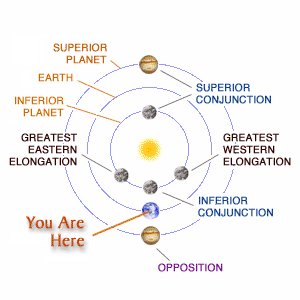Conjunction, when used in positional astronomy and astrology refers to the position of two heavenly bodies in relationship to their distances with one another. When observed from a certain point, such as the Earth, two heavenly bodies seem to be near each other and sometimes their nearness to one another can form patterns. The phenomenon is also referred to as an appulse.

There are two types of conjunctions that usually occur. These are inferior and superior conjunction. In an inferior conjunction, two planets lie in a line on the same side of the Sun, making the superior planet appear in opposition to the Sun as being observed from an inferior planet.
When heavenly bodies are observed from a superior planet and two planets are on the opposite side of the Sun, then they are said to be in superior conjunction with the Sun.
The terms inferior and superior conjunctions are commonly used to denote the positions of the inner planets Mercury and Venus, which are also called inferior planets when observed from the Earth. Nonetheless, the term can also be used to pertain to the position of other pair of planets as observed from another planet away from the Sun.
Planets, asteroids, and comets are said to be in conjunction when it is in conjunction with the Sun as observed from the Earth. The Earth’s moon is in conjunction with the sun during a New Moon.
Another type of conjunction, called quasi-conjunctions occurs when a planet in retrograde motion such as Mercury or Venus drops back in right ascension until it nearly allows another planet to overtake it. Nonetheless, that planet always resumes its forward motion and appears to draw away far from that planet again.
